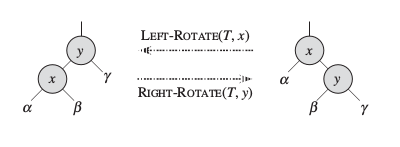Augmented Red-Black Tree
In the previous post, I used an augmented binary search tree to solve the following problem in \(O(n \log n)\) average time:
You are given an integer array nums and you have to return a new counts array. The counts array has the property where counts[i] is the number of smaller elements to the right of nums[i].
In this post, I’ll modify the algorithm to work for a self-balancing binary search tree. A self-balancing BST is a BST that always keeps its height small - of the order of \(O(\log n)\). Insertions into a balanced BST always take \(O(\log n)\) time, and thus my algorithm will have \(O(n \log n)\) worst-case complexity. One kind of self-balancing BSTs are red-black trees.
A red-black tree is a binary search tree where each node stores stores an additional color attribute, which satisfies the following properties:
- Each node can be either red or black.
- The root is black.
- All leaves are black and have NIL value.
- All simple paths from the root to leaves have the same number of black nodes.
- No two red nodes are adjacent.
Thanks to properties 4 and 5, a red-black tree with \(n\) nodes has height at most \(2(\lg n + 1)\), so insertion into a red-black tree has a worst-case \(O (\log n)\) complexity.
After a new node is inserted, the red-black tree goes through a fixup procedure to ensure that the properties 1-5 are fulfilled. I am not going to describe it in detail; you can read about it in Wikipedia or examine the code below. The important thing about the fixup procedure is that it only uses two basic operations: recoloring nodes and rotation.
The rotation operations on a binary search tree works as follows:

The operation LeftRotate transforms the configuration of the two nodes on the right into the configuration on the left. The inverse operation RightRotate transforms the configuration on the left into the configuration on the right. The letters \(\alpha\), \(\beta\) and \(\gamma\) represent arbitrary subtrees.
In the previous post, we augmented a node with an “lc” field to store the number of nodes in the lest subtree:
class Node:
def __init__(self, key, lc=0, left=None, right=None, parent=None):
self.key = key
self.lc = lc #how many nodes are in the left subtree of this node
self.left = left
self.right = right
self.parent = parentTo augment a red-black tree the same way, we need to ensure that this field is correctly updated during the fixup operation. Recoloring doesn’t change this number, and during rotation we only need to update the y node.
For the right rotation,
y.lc = y.lc - x.lc - 1For the left rotation,
y.lc = y.lc + x.lc + 1The full algorithm is below:
RED = "RED"
BLACK = "BLACK"
class AugNode: #Augmented node of a Red-black tree
def __init__(self, key, color, lc=0, left=None, right=None, parent=None):
self.color = color
self.key = key
self.lc = lc
self.left = left
self.right = right
self.parent = parent
class AugRBTree:
def __init__(self):
self.Nil = AugNode(None, BLACK, 0)
self.root = self.Nil
def LeftRotate(self, node):
y = node.right
node.right = y.left
y.left = node
y.lc = node.lc + y.lc + 1
if node.right != self.Nil:
node.right.parent = node
y.parent = node.parent
if node.parent == self.Nil:
self.root = y
elif node == node.parent.left:
node.parent.left = y
else:
node.parent.right = y
node.parent = y
def RightRotate(self, node):
y = node.left
node.left = y.right
y.right = node
node.lc = node.lc - y.lc - 1
if node.left != self.Nil:
node.left.parent = node
y.parent = node.parent
if node.parent == self.Nil:
self.root = y
elif node == node.parent.right:
node.parent.right = y
else:
node.parent.left = y
node.parent = y
def Insert(self, node):
node.lc = 0
y = self.Nil
x = self.root
st = x.lc
while x != self.Nil:
y = x
if x.key < node.key:
if x.right != self.Nil:
st = st + x.right.lc + 1
x = x.right
else:
if x.left != self.Nil:
st = st - x.lc + x.left.lc
x.lc += 1
x = x.left
node.parent = y
if y == self.Nil:
self.root = node
elif y.key < node.key:
y.right = node
st += 1
else:
y.left = node
y.lc += 1
node.color = RED
node.left = self.Nil
node.right = self.Nil
self.InsertFixup(node)
return st
def InsertFixup(self, z):
while z.parent.color == RED:
if z.parent == z.parent.parent.left:
uncle = z.parent.parent.right
if uncle.color == RED:
#recolor
uncle.color = BLACK
z.parent.color = BLACK
z.parent.parent.color = RED
z = z.parent.parent
else:
#if z is a right child turn it into a left child
if z == z.parent.right:
z = z.parent
self.LeftRotate(z)
z.parent.color = BLACK
z.parent.parent.color = RED
self.RightRotate(z.parent.parent)
else:
uncle = z.parent.parent.left
if uncle.color == RED:
#recolor
uncle.color = BLACK
z.parent.color = BLACK
z.parent.parent.color = RED
z = z.parent.parent
else:
if z == z.parent.left:
z = z.parent
self.RightRotate(z)
z.parent.color = BLACK
z.parent.parent.color = RED
self.LeftRotate(z.parent.parent)
self.root.color = BLACK
def right_and_smaller2(nums):
tree = AugRBTree()
result = []
for num in reversed(nums):
newnode = AugNode(num, BLACK)
result.append(tree.Insert(newnode))
return reversed(result)After moving a little further in studing data structures, I realized my invention closely resembles an Order Statistic Tree
An Order Statistic tree is a self-balancing binary tree where each node stores the total number of nodes below it, including itself (the NIL nodes’ size is defined as zero). An Order Statistic tree allows to
- insert elements in \(O(\log n)\) time
- find the rank of an element in \(O(\log n)\) time
- find the kth smallest element in \(O(\log n)\) time
So, an order statistic tree would serve just as well for solving our problem.
In the next post, I’ll describe another way to efficiently solve this problem with a different data structure: Fenwick tree.